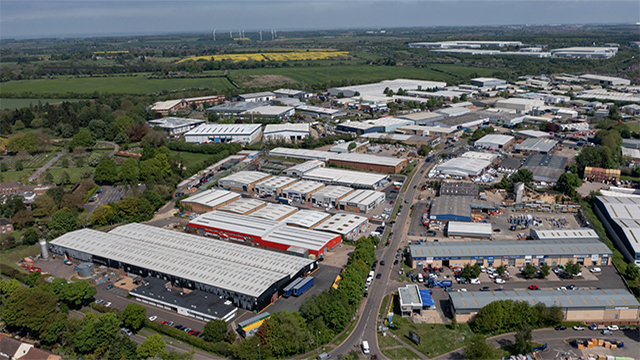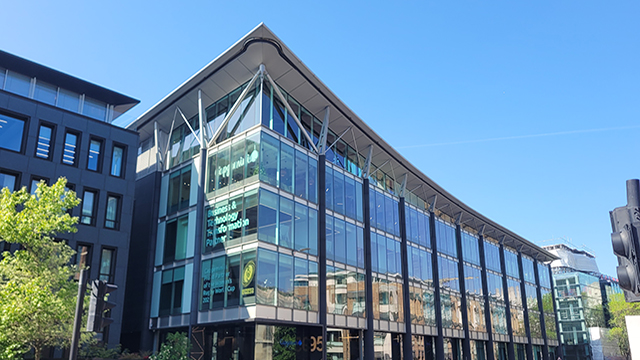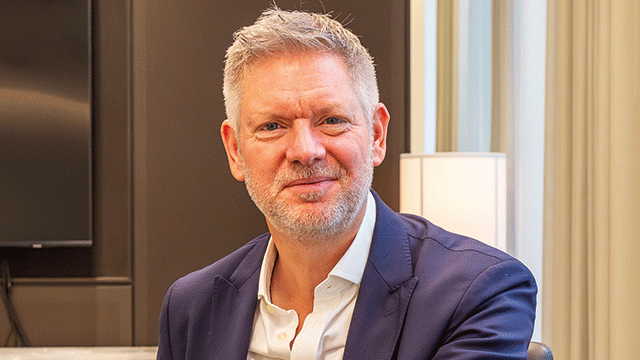The EG Interview: Julian Carey on Stenprop’s multi-let industrial revolution
It has been nearly three years since Stenprop’s leadership team listed the company on the London Stock Exchange with a goal of becoming the UK’s “leading multi-let industrial real estate business”, underpinned by “the development of a serviced industrial space model” and “cutting-edge technology”.
Given the wide range of properties that Stenprop owned across Europe at the time, including retail and healthcare, it was a bold proclamation. But the team’s drive – helped more recently by a shift in demand during the Covid-19 pandemic – means the company is now well on its way to having a 100% multi-let portfolio by March next year.
Managing director Julian Carey (pictured above) says investors are convinced. The company has started trading at a premium to net asset value in recent weeks, with its stock up by double digits on pre-Covid levels.
It has been nearly three years since Stenprop’s leadership team listed the company on the London Stock Exchange with a goal of becoming the UK’s “leading multi-let industrial real estate business”, underpinned by “the development of a serviced industrial space model” and “cutting-edge technology”.
Given the wide range of properties that Stenprop owned across Europe at the time, including retail and healthcare, it was a bold proclamation. But the team’s drive – helped more recently by a shift in demand during the Covid-19 pandemic – means the company is now well on its way to having a 100% multi-let portfolio by March next year.
Managing director Julian Carey (pictured above) says investors are convinced. The company has started trading at a premium to net asset value in recent weeks, with its stock up by double digits on pre-Covid levels.
“The transition [to multi-let] has gone to plan, almost to the day, which is amazing,” Carey tells EG, speaking on a Teams video call from his home in Gerrards Cross, Buckinghamshire. “We’ve hit our milestones and are ticking the ‘do as you say’ box. We like to think we are coming to the fruition of our strategy.”
UK multi-let industrial now accounts for almost three-quarters of the Guernsey-registered REIT’s portfolio by value – exceeding a 2018 target to nearly triple its 23% exposure to around 65% by March 2020.
The landlord has also made strides in meeting a goal of reducing its loan-to-value ratio to under 40% by March 2020, from a 49.2% average. LTV stood at 40% on drawn facilities at the end of December, falling to about 35% including free cash.
Competing in a crowded market
Stenprop’s portfolio was valued at £574.1m at the half-year mark last September, a 4.4% like-for-like valuation increase year-on-year. Since then, it has grown its multi-let unit count to 1,400.
During the year it sold €122m (£106m) of properties, including retail assets in Germany at a 20% premium to March 2020 book values, according to Carey. This year Stenprop aims to spend £130m on purpose-built, multi-let purchases, along with selling its remaining non-industrial properties in Germany, Switzerland and Guernsey.
But the battle to secure industrial assets is getting tougher. Despite hitting its £90m acquisition target last year, Stenprop planned for half of its deals to consist of portfolios – a target it missed as a growing number of firms looking to seed ventures with a big portfolio deal drives pricing to greater heights. Supply remains limited.
“We bought no portfolios, and that was not the plan,” says Carey, who joined the London and Johannesburg-listed company in 2017 after it bought his management business, C2 Capital, and its multi-let portfolio. “We’ve had to up our individual transactions to compensate for the fact that portfolios have been hard to come by. I don’t think that’s going to change in the short term.”
Until recently, investors have mostly focused on big-box or single-let warehousing let to prominent retailers or manufacturers. However, the occupier shift to ecommerce means that multi-let has held its ground. Carey says around half of new lettings last year were ecommerce-led, with emerging tenant types including crypto-mining businesses.
For Carey, the growing competition has validated Stenprop’s strategy, even if he could be forgiven for feeling frustrated that investors are now piling into a market he and colleagues identified years before. “I think if we completed the transition and everybody else was still uninterested, you might start questioning yourself a little bit,” he says. “It’s quite nice when [there’s] some reassurance that you’re doing the right thing.”
Acquisition-wise, Carey remains agnostic about geographies, provided each location is in or around densely populated areas. Carey highlights the North West as one of its top-performing regions; while he finds London and the South East compelling to a degree, yields have narrowed to “next to nothing”. British Land is closing in on its first logistics purchase – a Waitrose customer fulfilment centre in Enfield – at a yield of under 3%. Stenprop is paying initial yields of around 6%.
“Industrial has outperformed office and retail materially over a 30-year timeframe, and the reason for that outperformance is income,” says Carey. “As soon as you move away from what has delivered industrials performance in the long term, you’re playing a different game. There are very good reasons for doing that, but as a REIT we should be distributing income. We feel it’s good to still focus on that.”
Tech-driven services
In the meantime, further growth is on the cards. Staff count has jumped by almost 50% in the past 12 months as the company builds out its accounting, technology and on-site sales functions. Former St Modwen executive Paul Batho was hired earlier this month for a new senior development manager role, focusing on existing portfolio development and refurbishment opportunities as well as sourcing value-add acquisitions.
Along with scaling up the business, the goal is to expand the operating platform, with technology at the heart of its strategy. Initiatives that are being deployed this year include a new finance and operations system and a forecasting tool. Carey says the team is “gearing up” to offer more services and products as additional revenue streams.
“One of the big barriers to entry with MLI is the cost of management,” he says. “We want to bring that right down, and that’s where the platform’s being focused. The secondary part of that… is about growing revenue through additional products and services. We’ve spent a lot of time, effort and money on [expanding the platform].”
In time, this could evolve to include pioneering all-in-one package deals offering services such as broadband and utilities at fixed prices – taking Stenprop’s ambition to become a serviced industrial provider to the next level.
“SME industrial occupiers have the same wants and needs as SME occupiers in the office market,” says Carey. “They just happen to need a shed and not an office. Why would they not want flexibility, or a simple lease… where they don’t need to worry about maintaining the entire property, and just focus on their business?
“If we can deliver great customer service, they will pay a premium [for] that and will probably end up paying less than they would otherwise, and we will make a profit on it, which provides a really exciting challenge for our team.”
As the idea of “spaces as services” becomes more prevalent, real estate businesses are having to become more operational in nature. In turn, this has magnified the need for stronger data capabilities, giving rise to complexities that Carey is keen to conquer.
Despite the huge amount of activity happening in a landlord’s building, Carey points out that not much of the data produced as a result actually belongs to the landlord. “We’re trying to get around the point of trying to capture more of that information, which is readily available to us,” says Carey. “It sounds simple, but it’s really not. There are vast quantities of it.
“What you have to be good at is figuring out if something adds any value. There’s no point knowing what the weather is on every estate every day of the year, but it is quite useful to know which tenants are actually coming in and out of their buildings, because then you know who’s in occupation and who’s not.”
The big picture
Harnessing data and tech to grow income and occupancy will not be an easy feat. But Carey says it can be tackled, with a “series of easy wins that build confidence in the business”.
“We’re investing a lot in our systems,” he says. “We’re also upskilling in that we’ve had little wins along the way and we’re really excited about how that can progress further. It’s an iterative process.”
Never one to shy away from grand objectives, Carey says the ultimate goal is to “revolutionise the way that multi-let is managed in the UK” for all stakeholders, as well as for local communities around its estates and from an environmental perspective. “I think we can do all of that,” says Carey. Stated goals are normally taken with a pinch of salt but, so far, Stenprop has remained true to its word.
To send feedback, e-mail pui-guan.man@egi.co.uk or tweet @PuiGuanM or @estatesgazette











